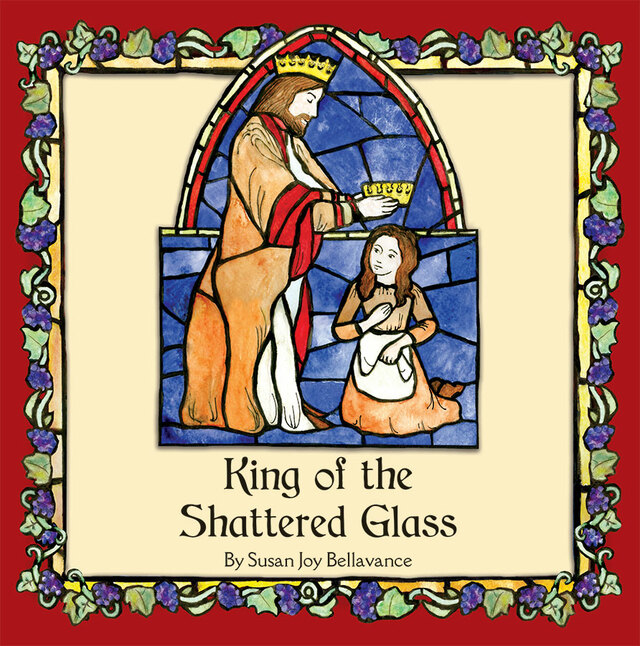
Christine Vincent reviews King of the Shattered Glass by Susan Bellavance.
Always in search of stories that nourish the soul, I recently found a treasure. King of the Shattered Glass by Susan Joy Bellavance, beautifully illustrated by Sara Tang, is a parable of the Sacrament of Reconciliation set in a medieval kingdom, in the time of early glass making. This book is marketed for children ages 6 to 10, but like all good stories it can be enjoyed by all ages.
King of the Shattered Glass is a perfect example of a book teaching the faith by means of entertainment. One could hardly imagine a better way to instill the essence of the Sacrament of Confession than reading this appealing tale about a young orphaned scullery maid and a kind king.

We tend to overlook the skill it takes to write a parable that is simple and easy to relate to, while conveying a complex message. Susan Bellavance has succeeded in creating a little masterpiece. She bases her parable on glass as a metaphor of the human heart. Here is her own poetic synopsis:
This is a story of the human heart,
Which, like glass, is as strong in its virtue
As it is brittle in its weakness. Like glass,
The heart can be mended by its Maker.
In the high middle ages, the time period King of the Shattered Glass is set in, glass was almost as mysterious as the human heart and almost as precious. Marguerite, a little, orphaned scullery maid, tends to break the precious glassware of her King. Although afraid of punishment, she always does what the King requires, taking the broken pieces to him. And every time, He forgives her. Although Marguerite loves her King very much, in her childish carelessness, she often shatters more pieces. When she breaks a great quantity of glass dishes at a feast, she is still brave enough to present the evidence of her crime to the King. He not only forgives her again, but he adopts her as his daughter. He also unveils to his subjects a beautiful stain glass window which he created from the broken pieces of glass.
The glass metaphor is many- faceted. There is the aspect of mystery and high value which is new to modern children. For us today, glass is something to be recycled. Then there is the strength, the beauty and the fragility of glass. It needs to be handled with care! The crown of the poetic message, however, shows how the King can fashion something beautiful from the shattered pieces, something more beautiful than the new and unblemished glass ever was.
Lovable side characters in the story add to the liveliness of the tale. There is the stout master chef Louis, who acts tough towards Marguerite but is truly concerned about her welfare. The mischievous glass blower’s son Giovanni likes to get Marguerite in trouble. Louis and Giovanni tempt Marguerite’s virtue in different ways.
Marguerite embodies an important requirement for growing in virtue: courage. She suffers from all the typical weaknesses of children, such as impulsiveness, desire for pleasure, carelessness, pride, but she also has the courage to confess and to repent.
A wise and wonderful penance the King imposes upon Marguerite requires her to love her enemy. She is to spend an entire week helping Giovanni whose teasing had caused her to break the King’s glass bowls. The girl finds that loving your enemy can change his heart.
Sara Tang’s traditional illustrations in rich stained-glass jewel tones perfectly complement the story. They are simple and rich at the same time, much like the narrative. The facial expressions clearly convey the emotions of the characters, the mischievousness of Giovanni, the worried concern of Louis, the changing emotions of Marguerite, from curiosity, stubbornness, and remorse, to peace. Most striking is the portrayal of the kindness of the King.
After reading King of the Shattered Glass with your kids, talking about repentance and confession will be easy and interesting. Just find the parallels between the King in the story and Jesus, Our King, who heals our hearts shattered by sin.
Discussion:
Our Lord Jesus liked to teach in parables. Why, do you think, are parables more effective than direct messages?
Copyright 2021 Christine Vincent
Image
About the Author

Christine Vincent
Christine Vincent is a homeschooling mother of eight. She holds a M.A. in English and has been freelancing as a writer for over twenty years. When she began teaching her children, she discovered how difficult it is to find children’s books that will nurture the Faith. She launched her website BooksForCatholicKids.org to make the hunt easier for other moms.


.png?width=1806&height=731&name=CatholicMom_hcfm_logo1_pos_871c_2728c%20(002).png)
Comments